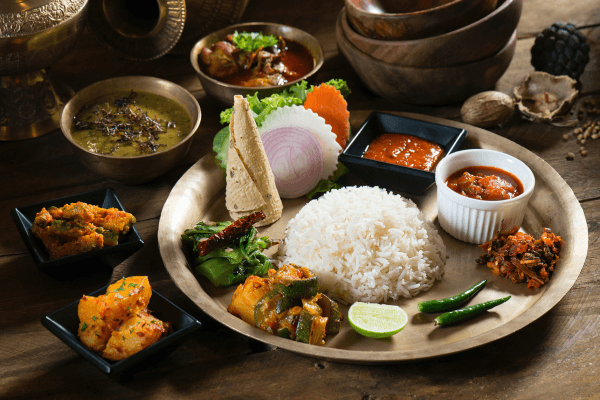As more people seek healthier grain options, millet and rice have both gained popularity. In recent times ancient grains have made a remarkable comeback in our modern diets. In many Asian nations, rice is a staple diet. Both grains have their benefits and unique properties.
In this blog, you will be able to learn about different millets, their beneficial properties on health and if millet or rice is a better option for blood sugar control.
Before we go into that, let us understand the difference between simple carbohydrates and complex carbohydrates.
Carbohydrates
It is an important and one of the three main macronutrients, found in many food sources. It is made up of fibre, starch and sugar. The nutrient quality is determined by the quantity of fibre, starch and sugar is present in the food. It is of two types:
Simple carbohydrates
This type of carbohydrate upon consumption, breaks easily and is used for energy in the body. They digest quickly in the body and also release glucose rapidly into the bloodstream. Simple carbohydrates are found naturally in fruit, sugar and milk. Other food sources are candies, honey, ice cream, syrups, fruit juices, chocolates, desserts, soft drinks and sweets.
Complex carbohydrates
They are nutritionally more packed than simple carbohydrates. Complex carbohydrates contain high fibre and its digestion is also slow. Two types of carbohydrates are fibre and starch. Having a meal rich in complex carbohydrates makes you feel full for longer, as it digests slowly and releases glucose slowly in the bloodstream.
Fibre also promotes regular bowel movements and controls cholesterol levels. Food sources include whole grains, millet, vegetables, beans, legumes and nuts.
Consuming complex carbohydrates provides more health benefits when consumed in the long term.
Now let us learn the types of millets and their nutrient profile.
Millets
Millets belong to the cereal species, they are small and edible seeds. It can be recommended as a tool to combat food insecurity due to its ability to grow in drought conditions. They majorly contain carbohydrates, protein accounts for 6-11% and fat 1.5-5%.
The two types of millets are short and large millets, respectively.
Pearl, foxtail, proso, and finger millets are examples of large millets. Small millets are kodo, barnyard, little, guinea, brown top, fonio and adlay. Common millets are pearl, finger, foxtail, proso, and barnyard.
Millets contain fibre, protein and micronutrients. They are low in glycaemic index and are gluten-free.
Nutrient profile of each millet (100g)
| Nutrient | Pearl | Finger | Foxtail | Proso | Barnyard | Sorghum | Barley | Kodo |
| Energy (kcal) | 1582 | 336 | 331 | 341 | 341 | 329 | 352 | 302 |
| Carbohydrates (g) | 72.8 | 67,5 | 60.9 | 70.4 | 67 | 72.1 | 77.7 | 65.9 |
| Protein (g) | 10.6 | 7.3 | 12.3 | 12.5 | 11.2 | 10.6 | 9.9 | 8.3 |
| Fat (g) | 4.2 | 1.5 | 4.3 | 1.1 | 4 | 6.9 | 1.2 | 1.4 |
| Fibre (g) | 1.3 | 3.6 | 8 | 2.2 | 7.6 | 10.6 | 15.6 | 9 |
Health benefits
- Good blood glucose control – Fibre and non-starch polysaccharides are high in fibre. They are non-digestible carbohydrates, they don’t digest easily in the gut so it does not increase the blood sugar levels. The glycaemic index of the millets is low. It makes it a good option for weight loss.
- Digestive health – Both soluble and insoluble fibre are present in millets. Prebiotic source is the insoluble fibre, it supports good bacteria in your gut, adds bulk to your stool and reduces the risk of colon cancer. It is also gluten-free and can be consumed by celiac disease without any discomfort.
- Improves heart health – In the gut, the soluble fibre traps fat and reduces the cholesterol levels. This lowers the risk of heart disease development. Magnesium, which is abundant in millet, helps avoid heart failure.
- Anti-oxidant – Millets contain tannins, phenols and phytates which protect the cells from damage and other metabolic conditions.
Other benefits
- It is usually consumed along with legumes, which increases the amino acid content and enhances the overall digestibility of protein.
- It can be used as fodder, making it more farming efficient.
- Reduces carbon footprint.
Rice
90% of rice is grown in Asia, making it a staple food in many Asian nations. Rice does not fall into simple carbohydrates but due to its processing methods, it mimics the characteristics of simple carbohydrates.
Rice at the time of harvest is covered with husk. The bran and husk layers are removed during the milling process. It then undergoes more processing and is polished with a coating of glucose and talc to give the white colour to rice. Rice that only undergoes the dehusking process is called brown rice. The further process removes the fibre from the rice, which makes it lose the complex carbohydrates component.
Nutrient profile (100g)
| Nutrient | Rice (milled) |
| Energy (kcal) | 345 |
| Carbohydrates (g) | 78.2 |
| Fat (g) | 2.2 |
| Protein (g) | 6.8 |
| Fibre (g) | 1.2 |
To answer the most asked question: Is rice a better option for people with Diabetes?
Rice can still be taken by people with diabetes but in moderation. It can also be paired with fibre-rich food products or protein-rich foods like vegetables, eggs, paneer, or legumes and pulses.
Portion controlling of rice is important as the glycaemic index of the rice is high when compared to millets. You can also switch to brown rice or parboiled rice for low glycaemic index options. Having an imbalanced diet can increase blood sugar levels.
Have a balanced meal of vegetables, protein and rice to avoid sugar spikes.
Glycaemic Index of millets and rice
| Food Products | Glycaemic index |
| Little millet | 64.2 |
| Kodo millet | 65.4 |
| Foxtail | 54.5 |
| Barnyard | 42.3 |
| Proso | 52.7 |
| Finger millet | 61.1 |
| Pearl millet | 52 |
| White rice | 89 |
| Brown or red rice | 50 |
Long-term studies showed reduced levels of HbA1c in people who consumed millet. The reduced levels are significantly lower compared to consuming a control rice-based diet HbA1c levels.
Eating in food order
Blood sugar levels are affected by the type and quantity of the food taken. Carbohydrates with high starch content have an impact on blood sugar levels and some are high in glycaemic index which also plays a role in increasing blood sugar levels.
Eating food order – First non-starchy vegetables, followed by protein and lastly carbohydrates has a positive effect on blood sugar levels. This is also known as food sequencing, meaning the order in which you eat the main components of a meal can reduce the blood sugar spikes. Your main nutrients in the meal are non-starchy vegetables, protein and carbohydrates.
In a subjects crossover design study, participants ate the same meal for 3 days but the order of eating the meal was changed.
First day the carbohydrates were taken and 10 minutes later followed by protein and non-starchy vegetables.
On the second day, they ate protein first followed by non-starchy vegetables and after a 10-minute break, they had carbohydrates.
On the last da,y they had non-starchy vegetables first, followed by protein and lastly carbohydrates.
Study results showed that when carbohydrates were taken lastly had a lower blood sugar response compared to eating it first.
In conclusion, millets are a good option as they have moderate to low GI. Rice can also be taken along with vegetables. Remember whether you are taking millets or rice, it is best to take it with high amounts of non-starchy vegetables and protein to have a positive impact on the blood sugar levels.
Kripa N,
Senior Clinical Dietitian, Simplyweight













